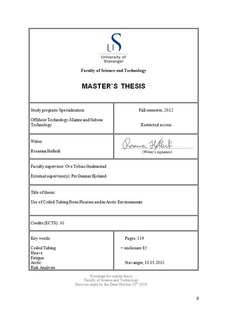| dc.contributor.author | Høllesli, Rosanna | |
| dc.date.accessioned | 2014-02-06T08:57:12Z | |
| dc.date.available | 2014-02-06T08:57:12Z | |
| dc.date.issued | 2013-01 | |
| dc.identifier.uri | http://hdl.handle.net/11250/183154 | |
| dc.description | Master's thesis in Offshore Technology-Marine and Subsea Technology | no_NO |
| dc.description.abstract | When coiled tubing (CT) operations are performed from floaters there is relative motion between the sea bottom and the topside equipment placed on the vessel deck. Some of the CT equipment is placed in a heave compensated tension frame (ACTF) that hangs in a tower structure on the vessel deck to keep constant distance to the well head. The reel placed on the vessel deck keeps constant coil tension during the operation by spooling coil on and off the reel to compensate for vessel motions. The result is that the strains induced in the coil when it is bent over the reel are repeated in each cycle (one cycle=vessel moving up and then down). This reduces the fatigue life of the exposed parts of the coil drastically.
This thesis explores the possibility to reduce the fatigue problem by replacing the gooseneck placed on the injector, which traditionally guides the coil, with a guide pipe that goes all the way from the reel to the injector placed in the ACTF. The guide pipe will have a much larger bend radius than the gooseneck and eliminate the need for spooling excess coil on and off the reel to keep constant coil tension when performing CT from floaters, by changing its bend radius with the vessel motions.
The guide pipe behavior during 3m heave was guesstimated and the strain behavior was compared with a comparable standard CT case. As the need for reeling coil on and off the reel was eliminated, something that induced a strain variation of up to almost 2% in every cycle, it was expected to get an increase in coil life. The estimated strain variation in each cycle was reduced to under 0.2 % when the guide pipe compensated for the relative motion by changing its bend radius. The result after the simplified calculations where factors as pipe ovality, surface and internal material defects and welds were not accounted for; was an increase in estimated number of tolerated cycles from about 300 to about 2000.
In addition to increasing the coil life, the improved coil conditions could expand the operational window and/or make more use of monohull vessels for performing CT operations possible. It is also assumed that the technology with small adjustments can make CT operations in the Arctic more feasible than with the existing technology as the CT will be protected from ice spray.
The hypothesis after this literature study is that a standard steel pipe with an inner layer of polymer can be used as guide pipe. Steel pipes are available and known to handle the expected loads and the polymer reduces the force needed to pull the coil through the guide pipe and minimize coil damage. The most promising polymer candidate found is a 70-80% polytetrafluorethylene (PTFE) and 20-30% polytetrafluorethylene (PEEK) composite. More research and practical experiments are needed to validate the hypothesis.
After one round of risk analysis a rig up and operation solution assumed to be feasible were found, this is called solution 2d and is illustrated from page 89 to 93. A significant amount of work remains, however, in order to conclude that the suggested solutions are feasible in real life. | no_NO |
| dc.language.iso | eng | no_NO |
| dc.publisher | University of Stavanger, Norway | no_NO |
| dc.relation.ispartofseries | Masteroppgave/UIS-TN-IKM/2012; | |
| dc.subject | offshore teknologi | no_NO |
| dc.subject | undervannsteknologi | no_NO |
| dc.subject | coiled tubing | no_NO |
| dc.subject | heave | no_NO |
| dc.subject | fatigue | no_NO |
| dc.subject | arctic | no_NO |
| dc.subject | risk analysis | no_NO |
| dc.title | Use of coiled tubing from floaters and in arctic environments | no_NO |
| dc.type | Master thesis | no_NO |
